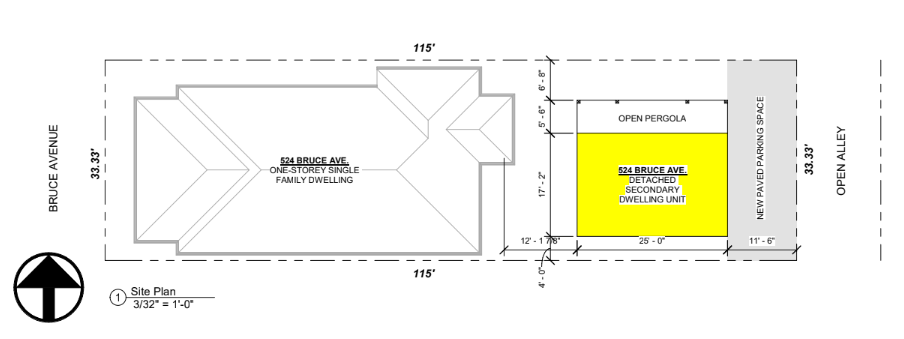I’m building a house.
Rendering of Tiny House (detached unit) at 524 Bruce Ave.
In case you haven’t heard. It’s taken a while - literally since the summer of last year and it’s become quite personal. So, let me give you the back story.
In November of 2018, I got a surprise call from someone I’d never met, Ken Acton, an architecture prof at St Clair College, who heard that I was doing some neighbourhood revitalization work. He told me about IncDev and that there was a workshop happening in Highland Park, MI the following week and that I should go. If there ever was a series of ‘universe’ moments in my life - this was it. I left that workshop with a light bulb having gone off and my brain shouting: “This is what you need. This is what Windsor needs. We need more people committed to the core neighbourhoods doing small projects to revitalize old buildings.” And so my quest began.
I started thinking about all the buildings I could rehab. I’m indebted to my childhood friend, Jazz for showing me all the old buildings around the core that I wanted to buy, but couldn’t afford. In the quest for the perfect building, lot, opportunity, I was struggling to get investors and community members to buy into various ideas to revitalize my neighbourhood. But I realized something during this time - why don’t I just do it? Even though I wasn’t brought up in this, I don’t have a real estate or contractor license, an MBA or a degree in economics, I realized that there is no formal school for being a developer. People enter this field from all backgrounds; mine just happened to be community development.
All of the work that I had been doing was, in fact, laying the groundwork to take the plunge into actually building something. Really knowing the neighbourhood, building a network of relationships, and getting a sense of what it needs is the starting point for any good development decisions. This feeling of “Hey, I can do this too!” began to permeate my being and kept me awake at night.
The real estate and development industry is dominated by people who only think about buildings in terms of profit - how much can this building make me? But we don’t often think about real estate in terms of community building, yet the investments in the built environment have a massive amount of power to change a neighbourhood, for good or for ill, in small or large ways. Joel Dixon recently said this on a Strong Towns webinar: “Real estate is a community development tool.” Not only did this resonate, but it encouraged me to finally take the plunge.
Look at all the massive developments that are going to be changing the character, density, and feeling of our downtown: Grace site, the old Junction property, Quicken Loans Building catalyzing other developments along Chatham St., Canada Building & Knights of Columbus Building, and the Valente Building which is close to completion. As exciting as these developments are, when one ventures out into the surrounding neighbourhoods, the buildings and residents will tell you a different story. There is still investment needed in many properties that are vacant, under-utilized, and run down. And while the larger developments will catalyze growth and generate activity, we also need to make sure that our neighbourhoods are safe, affordable, and equitable (like they have historically been in many parts of Windsor, although the housing market has been changing that dynamic). I am not meaning to suggest that these big developments are bad or unneeded, but I am also not a fan of only giving money to big developers via CIP incentives. (The inclusion of Neighbourhood Rehabilitation Grant for downtown was recently passed, therefore reversing last City Council’s previous decision - more on that in a later blog post.)
Think about it this way: having 10 people in a neighbourhood add 10 units to their separate properties would create a 10 new incomes streams for each of these individual property owners. Contrast this to one developer, building one 10 unit building and likely concentrating all of that investment into one company or person (and taking it out of the neighbourhood). Not only does it raise rental prices, it also takes the investment and attention to the property elsewhere too. By nature, small units are more affordable, since they cost less to build and maintain, thereby potentially allowing a lower cost of rent, while at the same time, providing another income source to somewhere who already lives in that neighbourhood (the primary unit).
‘Gentle-fication’ - coined by Monte Anderson, means the act of incrementally investing in neighbourhoods through the creation of additional units, is now possible through the secondary suite bylaw and we need it more than ever. While Windsor is not landlocked, in terms of availability of greenfield land to build single family homes, it is not the most efficient, and certainly not the most environmentally conscious form of urban development. Toronto calls it adding “gentle” density through laneway cottages, secondary units, etc. in the “yellow belt” around the city’s high density core, but some acknowledge that even that isn’t enough to address the housing crisis. Windsor is feeling that crunch with the steep increase in housing prices which has not slowed down during the pandemic. Basically, we need to move away from single family homes in order to address both the increase in demand for housing and also our environmental crisis. From a macro level, it is important for the health of our city to add more good quality units to the housing supply; from a micro level, it is good to encourage homeowners to invest in their properties and also be present landlords within their neighbourhoods.
Therefore, I write, say, and now do all of this to announce to the world that another way of building and living is possible. If I was going to start advocating for more small-scale development projects to be done by local residents, I felt like I should really walk the talk. The fact that this world is totally unknown should not be a reason to not at least try. In 2019, when I was finally in a position to be purchasing a home and needed to begin to build wealth on my own as a single parent returning to school, I figured this would be the smart, equitable way to do so.
And so here we are.
It is in the last few months that I have honed in on a bigger vision for what this could be. I began to look to others to inspire me along this journey: Gracen from IncDev, Bernice from Buffalove, Jen from Jenifer Acosta Development. Locally, Deidre & Stephanie from Border City Living have both a passion for showcasing this work and jumping in to doing some projects themselves. They have been amazing resources and their blog has helped paint a different picture of urban living in our core neighbourhoods.
But I know that I need to start small (both literally and figuratively) and expand from there. That is why I’ve chosen a tiny house - 430 square feet - the smallest you can legally build in Windsor as the project that I am going to cut my teeth on. I’m on an undersized lot, like many others in the core. If you can build one of these in my yard, they’ll be “easier” on pretty much any other lot in our city. (I put “easier” in quotations, because small-scale projects are never really that easy.)
So, after one year of initial design ideas, bylaw changes, building permit applications, and general coordination of this project, I have my fingers crossed that construction will finally begin in the next week (trying not to jinx it!). I will be informally showcasing it on my Instagram feed (@cipkardevelopment), and Border City Living has graciously offered to do a before & after post on their site. I’ll be the second detached new build (@NC Capital beat me to it by a few months!), but I will be the smallest. Supreme Services is doing the build and has been amazing at helping me navigate the ins and outs of the construction world. I’m so excited to share the journey of 524 Bruce with you and, now you know where to find me should you want to take a peak or have any questions.
Site Plan for Tiny House (detached unit) at 524 Bruce Ave.


